Principles of Administration Report: Office Management Analysis
VerifiedAdded on 2020/06/06
|14
|4269
|55
Report
AI Summary
This report provides a comprehensive overview of the principles of administration, covering various aspects of office management and business operations. It begins with the legal requirements related to office facilities, including health and safety, and describes typical services provided. The report then outlines procedures for establishing office management, managing resources, and monitoring work flows. It also discusses support and welfare facilities for office workers. Furthermore, the report delves into legal obligations of employers and employees regarding health and safety, accident procedures, and the importance of meeting minutes, including their legal implications and accuracy. It also covers different types of meetings, the roles of the chair and other participants, and techniques for facilitating meetings. The report further examines the use of targets and budgets, work allocation, quality management, and techniques for improving team outputs. Finally, it explores the characteristics and planning of different types of events, including resource identification and information requirements for delegates.
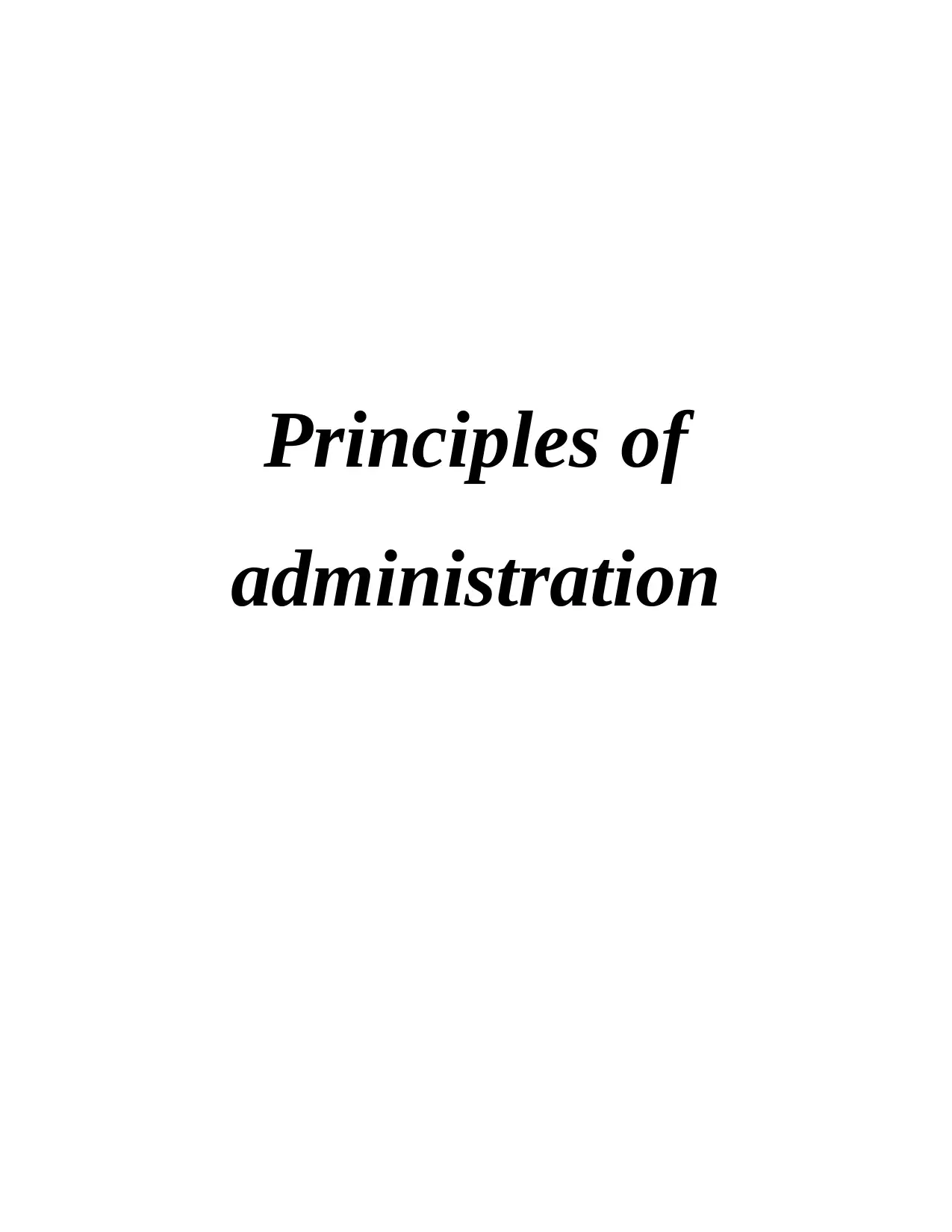
Principles of
administration
administration
Paraphrase This Document
Need a fresh take? Get an instant paraphrase of this document with our AI Paraphraser
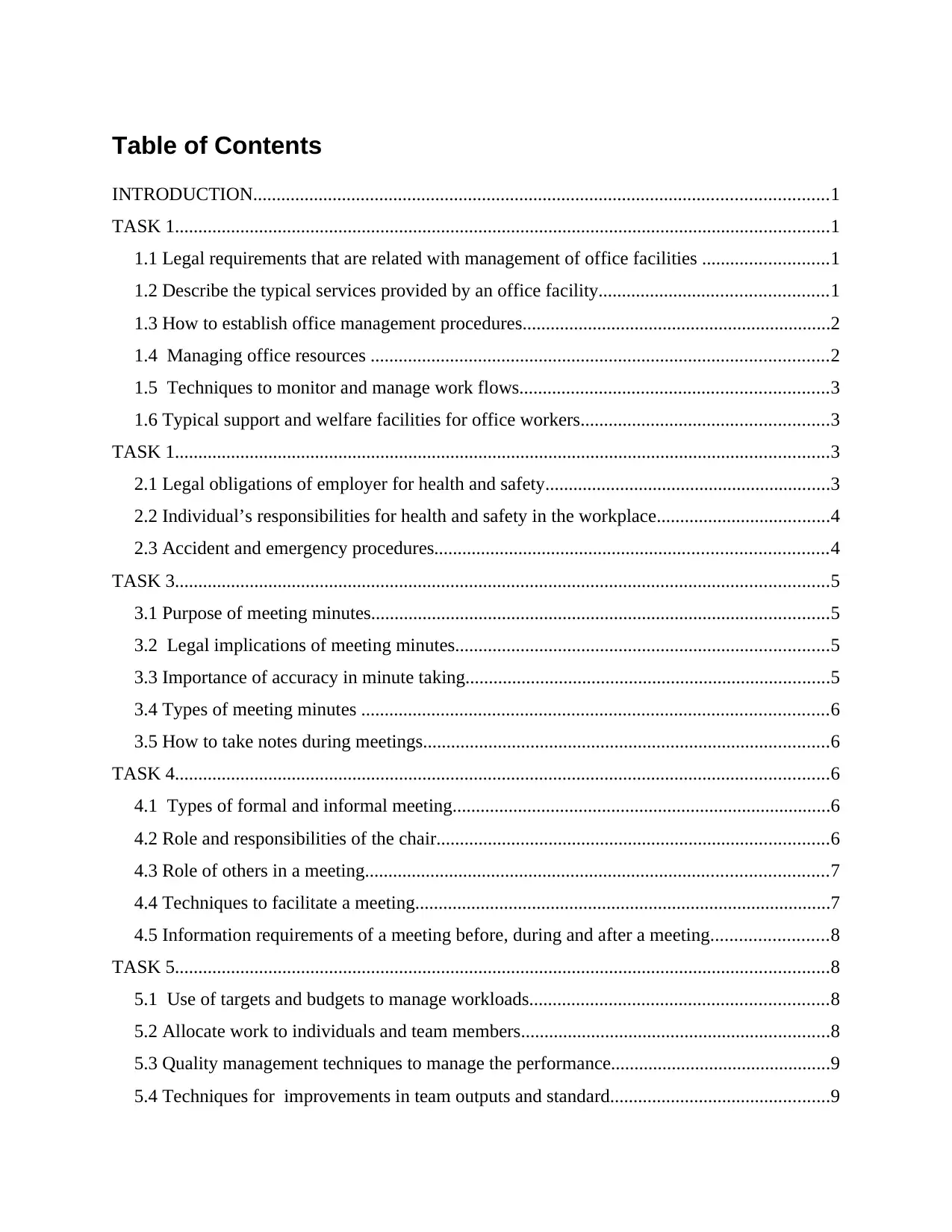
Table of Contents
INTRODUCTION...........................................................................................................................1
TASK 1............................................................................................................................................1
1.1 Legal requirements that are related with management of office facilities ...........................1
1.2 Describe the typical services provided by an office facility.................................................1
1.3 How to establish office management procedures..................................................................2
1.4 Managing office resources ..................................................................................................2
1.5 Techniques to monitor and manage work flows..................................................................3
1.6 Typical support and welfare facilities for office workers.....................................................3
TASK 1............................................................................................................................................3
2.1 Legal obligations of employer for health and safety.............................................................3
2.2 Individual’s responsibilities for health and safety in the workplace.....................................4
2.3 Accident and emergency procedures....................................................................................4
TASK 3............................................................................................................................................5
3.1 Purpose of meeting minutes..................................................................................................5
3.2 Legal implications of meeting minutes................................................................................5
3.3 Importance of accuracy in minute taking..............................................................................5
3.4 Types of meeting minutes ....................................................................................................6
3.5 How to take notes during meetings.......................................................................................6
TASK 4............................................................................................................................................6
4.1 Types of formal and informal meeting.................................................................................6
4.2 Role and responsibilities of the chair....................................................................................6
4.3 Role of others in a meeting...................................................................................................7
4.4 Techniques to facilitate a meeting.........................................................................................7
4.5 Information requirements of a meeting before, during and after a meeting.........................8
TASK 5............................................................................................................................................8
5.1 Use of targets and budgets to manage workloads................................................................8
5.2 Allocate work to individuals and team members..................................................................8
5.3 Quality management techniques to manage the performance...............................................9
5.4 Techniques for improvements in team outputs and standard...............................................9
INTRODUCTION...........................................................................................................................1
TASK 1............................................................................................................................................1
1.1 Legal requirements that are related with management of office facilities ...........................1
1.2 Describe the typical services provided by an office facility.................................................1
1.3 How to establish office management procedures..................................................................2
1.4 Managing office resources ..................................................................................................2
1.5 Techniques to monitor and manage work flows..................................................................3
1.6 Typical support and welfare facilities for office workers.....................................................3
TASK 1............................................................................................................................................3
2.1 Legal obligations of employer for health and safety.............................................................3
2.2 Individual’s responsibilities for health and safety in the workplace.....................................4
2.3 Accident and emergency procedures....................................................................................4
TASK 3............................................................................................................................................5
3.1 Purpose of meeting minutes..................................................................................................5
3.2 Legal implications of meeting minutes................................................................................5
3.3 Importance of accuracy in minute taking..............................................................................5
3.4 Types of meeting minutes ....................................................................................................6
3.5 How to take notes during meetings.......................................................................................6
TASK 4............................................................................................................................................6
4.1 Types of formal and informal meeting.................................................................................6
4.2 Role and responsibilities of the chair....................................................................................6
4.3 Role of others in a meeting...................................................................................................7
4.4 Techniques to facilitate a meeting.........................................................................................7
4.5 Information requirements of a meeting before, during and after a meeting.........................8
TASK 5............................................................................................................................................8
5.1 Use of targets and budgets to manage workloads................................................................8
5.2 Allocate work to individuals and team members..................................................................8
5.3 Quality management techniques to manage the performance...............................................9
5.4 Techniques for improvements in team outputs and standard...............................................9
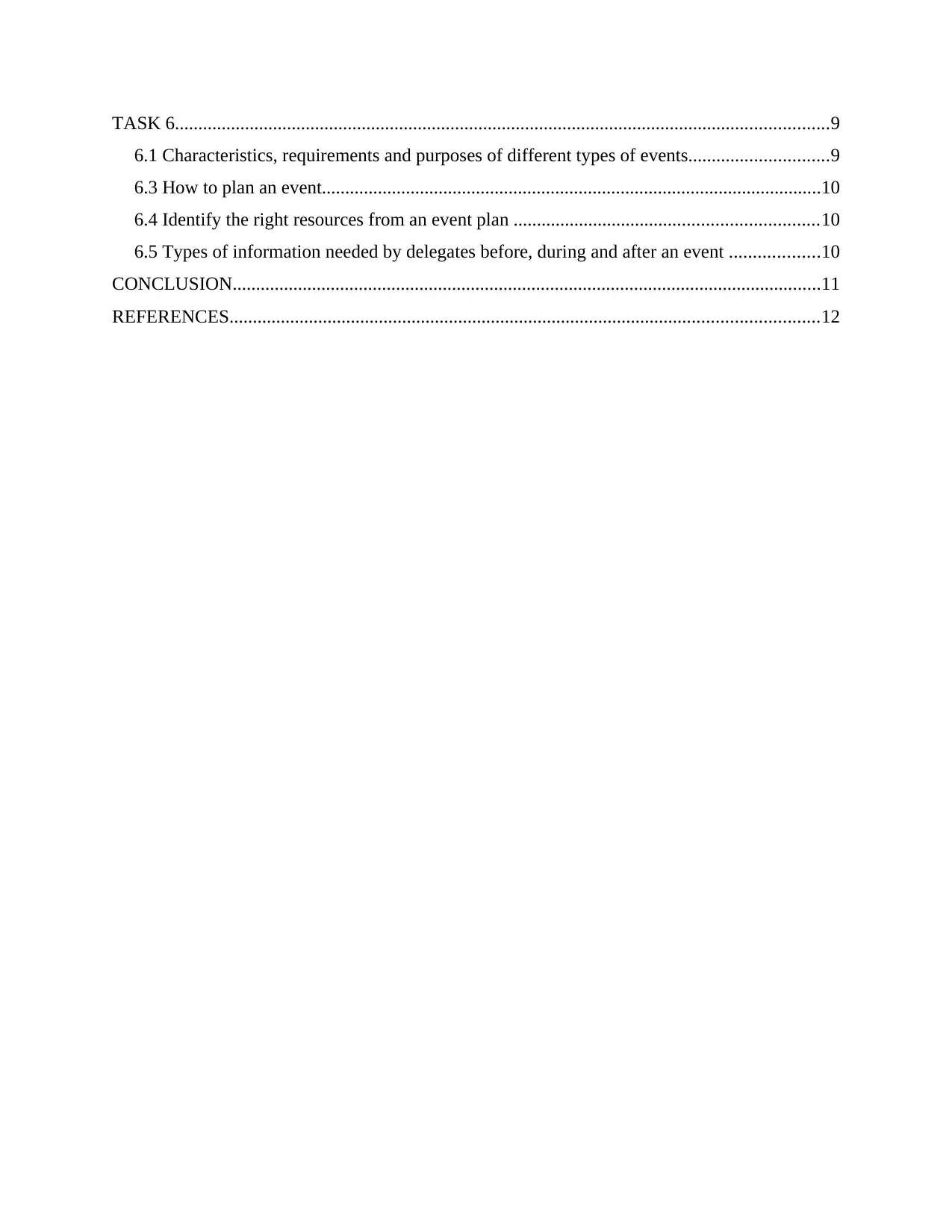
TASK 6............................................................................................................................................9
6.1 Characteristics, requirements and purposes of different types of events..............................9
6.3 How to plan an event...........................................................................................................10
6.4 Identify the right resources from an event plan .................................................................10
6.5 Types of information needed by delegates before, during and after an event ...................10
CONCLUSION..............................................................................................................................11
REFERENCES..............................................................................................................................12
6.1 Characteristics, requirements and purposes of different types of events..............................9
6.3 How to plan an event...........................................................................................................10
6.4 Identify the right resources from an event plan .................................................................10
6.5 Types of information needed by delegates before, during and after an event ...................10
CONCLUSION..............................................................................................................................11
REFERENCES..............................................................................................................................12
⊘ This is a preview!⊘
Do you want full access?
Subscribe today to unlock all pages.

Trusted by 1+ million students worldwide
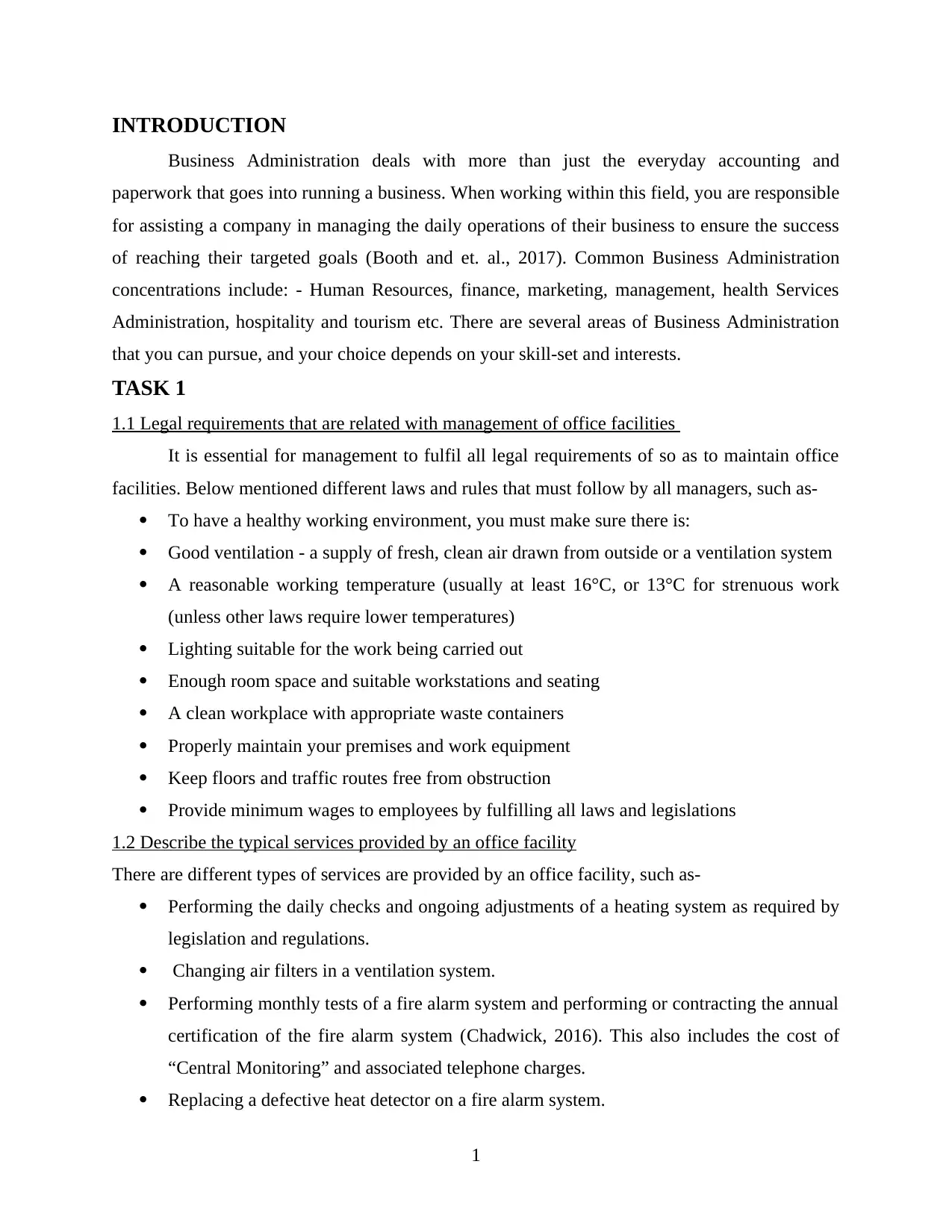
INTRODUCTION
Business Administration deals with more than just the everyday accounting and
paperwork that goes into running a business. When working within this field, you are responsible
for assisting a company in managing the daily operations of their business to ensure the success
of reaching their targeted goals (Booth and et. al., 2017). Common Business Administration
concentrations include: - Human Resources, finance, marketing, management, health Services
Administration, hospitality and tourism etc. There are several areas of Business Administration
that you can pursue, and your choice depends on your skill-set and interests.
TASK 1
1.1 Legal requirements that are related with management of office facilities
It is essential for management to fulfil all legal requirements of so as to maintain office
facilities. Below mentioned different laws and rules that must follow by all managers, such as-
To have a healthy working environment, you must make sure there is:
Good ventilation - a supply of fresh, clean air drawn from outside or a ventilation system
A reasonable working temperature (usually at least 16°C, or 13°C for strenuous work
(unless other laws require lower temperatures)
Lighting suitable for the work being carried out
Enough room space and suitable workstations and seating
A clean workplace with appropriate waste containers
Properly maintain your premises and work equipment
Keep floors and traffic routes free from obstruction
Provide minimum wages to employees by fulfilling all laws and legislations
1.2 Describe the typical services provided by an office facility
There are different types of services are provided by an office facility, such as-
Performing the daily checks and ongoing adjustments of a heating system as required by
legislation and regulations.
Changing air filters in a ventilation system.
Performing monthly tests of a fire alarm system and performing or contracting the annual
certification of the fire alarm system (Chadwick, 2016). This also includes the cost of
“Central Monitoring” and associated telephone charges.
Replacing a defective heat detector on a fire alarm system.
1
Business Administration deals with more than just the everyday accounting and
paperwork that goes into running a business. When working within this field, you are responsible
for assisting a company in managing the daily operations of their business to ensure the success
of reaching their targeted goals (Booth and et. al., 2017). Common Business Administration
concentrations include: - Human Resources, finance, marketing, management, health Services
Administration, hospitality and tourism etc. There are several areas of Business Administration
that you can pursue, and your choice depends on your skill-set and interests.
TASK 1
1.1 Legal requirements that are related with management of office facilities
It is essential for management to fulfil all legal requirements of so as to maintain office
facilities. Below mentioned different laws and rules that must follow by all managers, such as-
To have a healthy working environment, you must make sure there is:
Good ventilation - a supply of fresh, clean air drawn from outside or a ventilation system
A reasonable working temperature (usually at least 16°C, or 13°C for strenuous work
(unless other laws require lower temperatures)
Lighting suitable for the work being carried out
Enough room space and suitable workstations and seating
A clean workplace with appropriate waste containers
Properly maintain your premises and work equipment
Keep floors and traffic routes free from obstruction
Provide minimum wages to employees by fulfilling all laws and legislations
1.2 Describe the typical services provided by an office facility
There are different types of services are provided by an office facility, such as-
Performing the daily checks and ongoing adjustments of a heating system as required by
legislation and regulations.
Changing air filters in a ventilation system.
Performing monthly tests of a fire alarm system and performing or contracting the annual
certification of the fire alarm system (Chadwick, 2016). This also includes the cost of
“Central Monitoring” and associated telephone charges.
Replacing a defective heat detector on a fire alarm system.
1
Paraphrase This Document
Need a fresh take? Get an instant paraphrase of this document with our AI Paraphraser
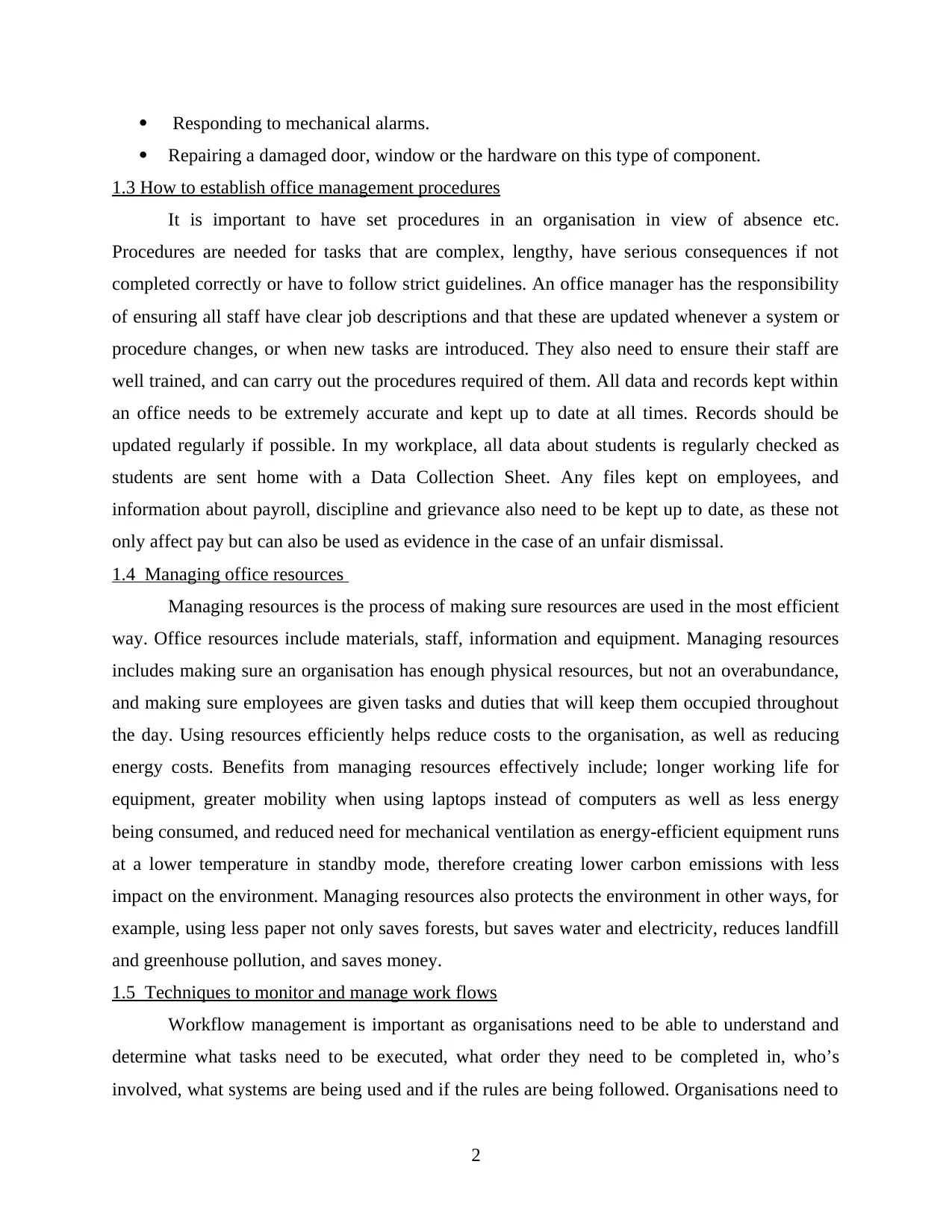
Responding to mechanical alarms.
Repairing a damaged door, window or the hardware on this type of component.
1.3 How to establish office management procedures
It is important to have set procedures in an organisation in view of absence etc.
Procedures are needed for tasks that are complex, lengthy, have serious consequences if not
completed correctly or have to follow strict guidelines. An office manager has the responsibility
of ensuring all staff have clear job descriptions and that these are updated whenever a system or
procedure changes, or when new tasks are introduced. They also need to ensure their staff are
well trained, and can carry out the procedures required of them. All data and records kept within
an office needs to be extremely accurate and kept up to date at all times. Records should be
updated regularly if possible. In my workplace, all data about students is regularly checked as
students are sent home with a Data Collection Sheet. Any files kept on employees, and
information about payroll, discipline and grievance also need to be kept up to date, as these not
only affect pay but can also be used as evidence in the case of an unfair dismissal.
1.4 Managing office resources
Managing resources is the process of making sure resources are used in the most efficient
way. Office resources include materials, staff, information and equipment. Managing resources
includes making sure an organisation has enough physical resources, but not an overabundance,
and making sure employees are given tasks and duties that will keep them occupied throughout
the day. Using resources efficiently helps reduce costs to the organisation, as well as reducing
energy costs. Benefits from managing resources effectively include; longer working life for
equipment, greater mobility when using laptops instead of computers as well as less energy
being consumed, and reduced need for mechanical ventilation as energy-efficient equipment runs
at a lower temperature in standby mode, therefore creating lower carbon emissions with less
impact on the environment. Managing resources also protects the environment in other ways, for
example, using less paper not only saves forests, but saves water and electricity, reduces landfill
and greenhouse pollution, and saves money.
1.5 Techniques to monitor and manage work flows
Workflow management is important as organisations need to be able to understand and
determine what tasks need to be executed, what order they need to be completed in, who’s
involved, what systems are being used and if the rules are being followed. Organisations need to
2
Repairing a damaged door, window or the hardware on this type of component.
1.3 How to establish office management procedures
It is important to have set procedures in an organisation in view of absence etc.
Procedures are needed for tasks that are complex, lengthy, have serious consequences if not
completed correctly or have to follow strict guidelines. An office manager has the responsibility
of ensuring all staff have clear job descriptions and that these are updated whenever a system or
procedure changes, or when new tasks are introduced. They also need to ensure their staff are
well trained, and can carry out the procedures required of them. All data and records kept within
an office needs to be extremely accurate and kept up to date at all times. Records should be
updated regularly if possible. In my workplace, all data about students is regularly checked as
students are sent home with a Data Collection Sheet. Any files kept on employees, and
information about payroll, discipline and grievance also need to be kept up to date, as these not
only affect pay but can also be used as evidence in the case of an unfair dismissal.
1.4 Managing office resources
Managing resources is the process of making sure resources are used in the most efficient
way. Office resources include materials, staff, information and equipment. Managing resources
includes making sure an organisation has enough physical resources, but not an overabundance,
and making sure employees are given tasks and duties that will keep them occupied throughout
the day. Using resources efficiently helps reduce costs to the organisation, as well as reducing
energy costs. Benefits from managing resources effectively include; longer working life for
equipment, greater mobility when using laptops instead of computers as well as less energy
being consumed, and reduced need for mechanical ventilation as energy-efficient equipment runs
at a lower temperature in standby mode, therefore creating lower carbon emissions with less
impact on the environment. Managing resources also protects the environment in other ways, for
example, using less paper not only saves forests, but saves water and electricity, reduces landfill
and greenhouse pollution, and saves money.
1.5 Techniques to monitor and manage work flows
Workflow management is important as organisations need to be able to understand and
determine what tasks need to be executed, what order they need to be completed in, who’s
involved, what systems are being used and if the rules are being followed. Organisations need to
2
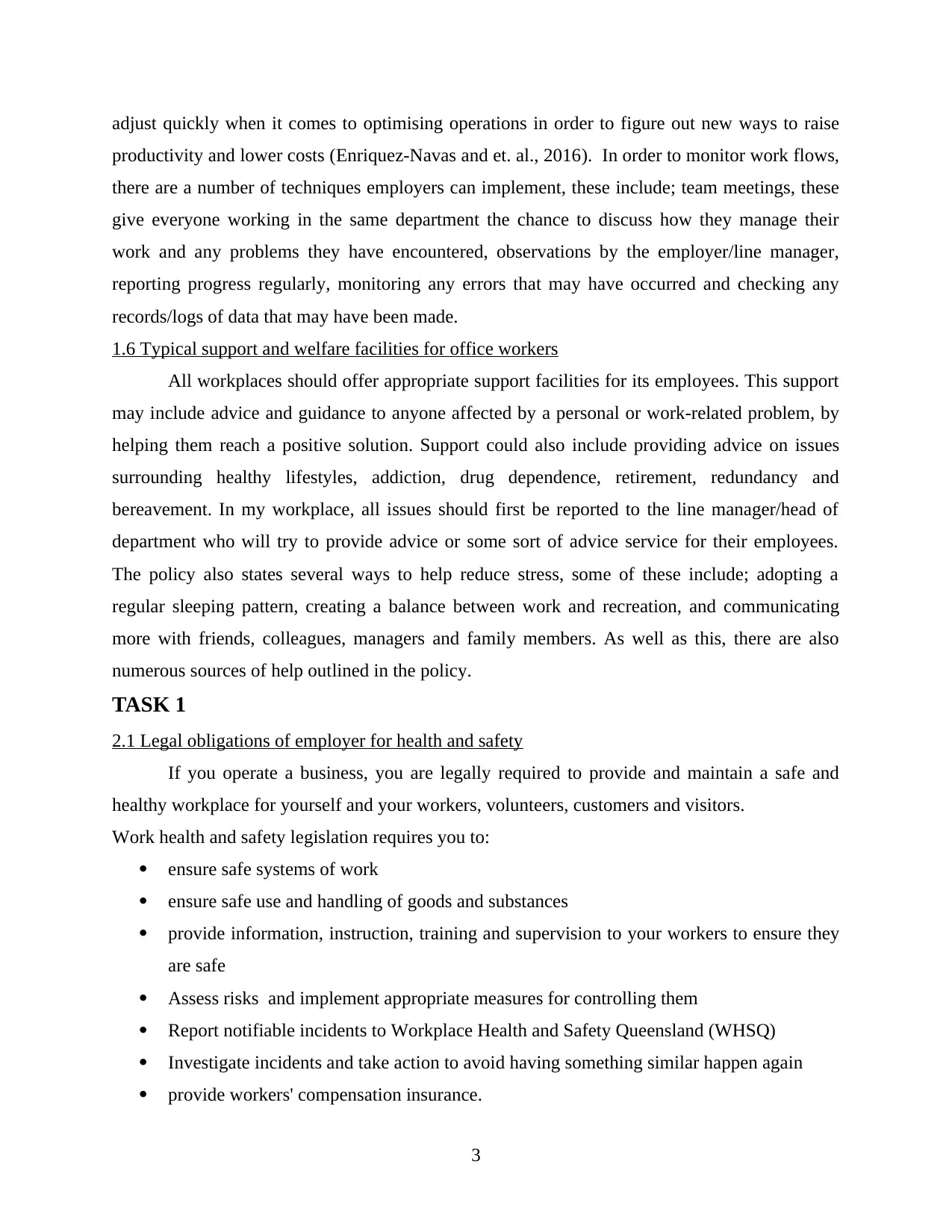
adjust quickly when it comes to optimising operations in order to figure out new ways to raise
productivity and lower costs (Enriquez-Navas and et. al., 2016). In order to monitor work flows,
there are a number of techniques employers can implement, these include; team meetings, these
give everyone working in the same department the chance to discuss how they manage their
work and any problems they have encountered, observations by the employer/line manager,
reporting progress regularly, monitoring any errors that may have occurred and checking any
records/logs of data that may have been made.
1.6 Typical support and welfare facilities for office workers
All workplaces should offer appropriate support facilities for its employees. This support
may include advice and guidance to anyone affected by a personal or work-related problem, by
helping them reach a positive solution. Support could also include providing advice on issues
surrounding healthy lifestyles, addiction, drug dependence, retirement, redundancy and
bereavement. In my workplace, all issues should first be reported to the line manager/head of
department who will try to provide advice or some sort of advice service for their employees.
The policy also states several ways to help reduce stress, some of these include; adopting a
regular sleeping pattern, creating a balance between work and recreation, and communicating
more with friends, colleagues, managers and family members. As well as this, there are also
numerous sources of help outlined in the policy.
TASK 1
2.1 Legal obligations of employer for health and safety
If you operate a business, you are legally required to provide and maintain a safe and
healthy workplace for yourself and your workers, volunteers, customers and visitors.
Work health and safety legislation requires you to:
ensure safe systems of work
ensure safe use and handling of goods and substances
provide information, instruction, training and supervision to your workers to ensure they
are safe
Assess risks and implement appropriate measures for controlling them
Report notifiable incidents to Workplace Health and Safety Queensland (WHSQ)
Investigate incidents and take action to avoid having something similar happen again
provide workers' compensation insurance.
3
productivity and lower costs (Enriquez-Navas and et. al., 2016). In order to monitor work flows,
there are a number of techniques employers can implement, these include; team meetings, these
give everyone working in the same department the chance to discuss how they manage their
work and any problems they have encountered, observations by the employer/line manager,
reporting progress regularly, monitoring any errors that may have occurred and checking any
records/logs of data that may have been made.
1.6 Typical support and welfare facilities for office workers
All workplaces should offer appropriate support facilities for its employees. This support
may include advice and guidance to anyone affected by a personal or work-related problem, by
helping them reach a positive solution. Support could also include providing advice on issues
surrounding healthy lifestyles, addiction, drug dependence, retirement, redundancy and
bereavement. In my workplace, all issues should first be reported to the line manager/head of
department who will try to provide advice or some sort of advice service for their employees.
The policy also states several ways to help reduce stress, some of these include; adopting a
regular sleeping pattern, creating a balance between work and recreation, and communicating
more with friends, colleagues, managers and family members. As well as this, there are also
numerous sources of help outlined in the policy.
TASK 1
2.1 Legal obligations of employer for health and safety
If you operate a business, you are legally required to provide and maintain a safe and
healthy workplace for yourself and your workers, volunteers, customers and visitors.
Work health and safety legislation requires you to:
ensure safe systems of work
ensure safe use and handling of goods and substances
provide information, instruction, training and supervision to your workers to ensure they
are safe
Assess risks and implement appropriate measures for controlling them
Report notifiable incidents to Workplace Health and Safety Queensland (WHSQ)
Investigate incidents and take action to avoid having something similar happen again
provide workers' compensation insurance.
3
⊘ This is a preview!⊘
Do you want full access?
Subscribe today to unlock all pages.

Trusted by 1+ million students worldwide
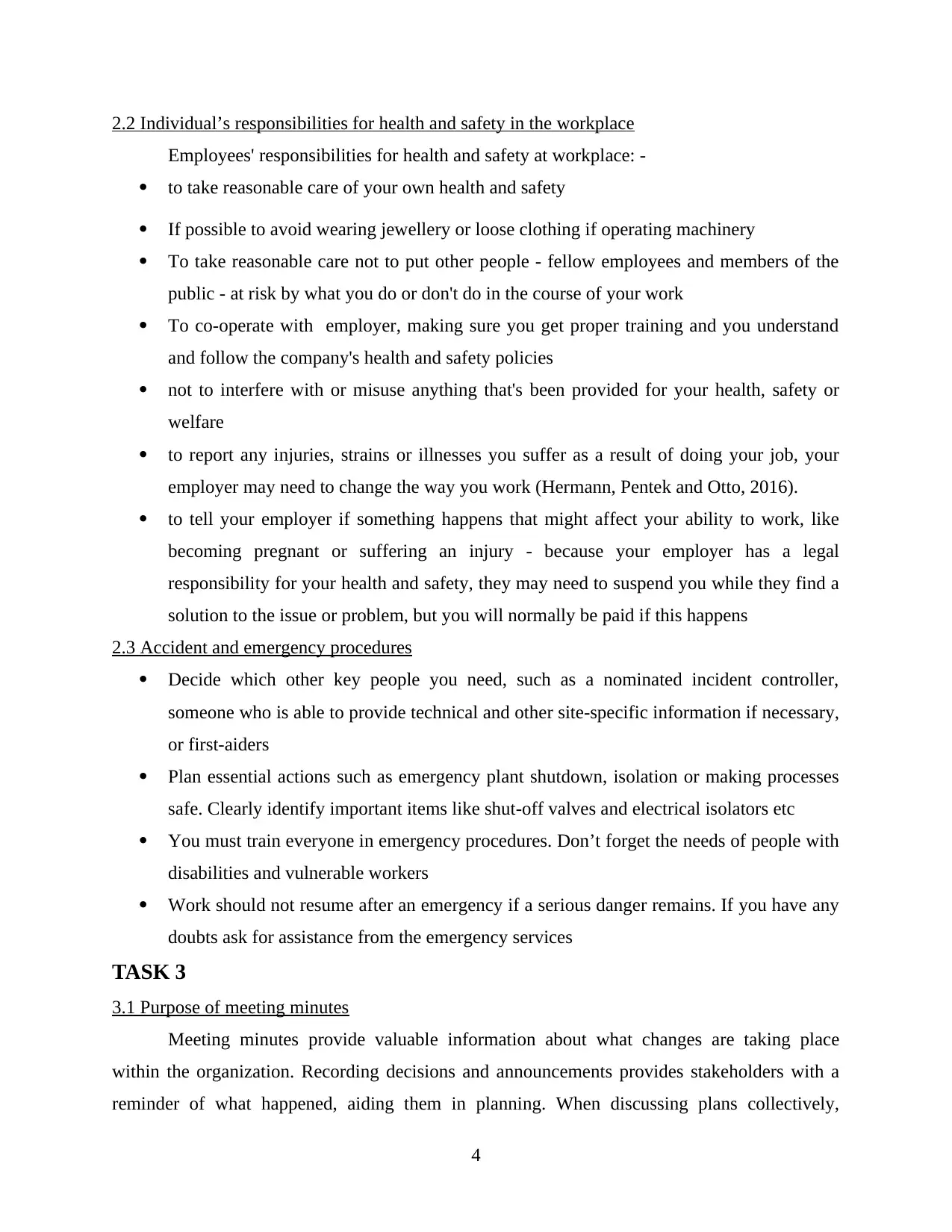
2.2 Individual’s responsibilities for health and safety in the workplace
Employees' responsibilities for health and safety at workplace: -
to take reasonable care of your own health and safety
If possible to avoid wearing jewellery or loose clothing if operating machinery
To take reasonable care not to put other people - fellow employees and members of the
public - at risk by what you do or don't do in the course of your work
To co-operate with employer, making sure you get proper training and you understand
and follow the company's health and safety policies
not to interfere with or misuse anything that's been provided for your health, safety or
welfare
to report any injuries, strains or illnesses you suffer as a result of doing your job, your
employer may need to change the way you work (Hermann, Pentek and Otto, 2016).
to tell your employer if something happens that might affect your ability to work, like
becoming pregnant or suffering an injury - because your employer has a legal
responsibility for your health and safety, they may need to suspend you while they find a
solution to the issue or problem, but you will normally be paid if this happens
2.3 Accident and emergency procedures
Decide which other key people you need, such as a nominated incident controller,
someone who is able to provide technical and other site-specific information if necessary,
or first-aiders
Plan essential actions such as emergency plant shutdown, isolation or making processes
safe. Clearly identify important items like shut-off valves and electrical isolators etc
You must train everyone in emergency procedures. Don’t forget the needs of people with
disabilities and vulnerable workers
Work should not resume after an emergency if a serious danger remains. If you have any
doubts ask for assistance from the emergency services
TASK 3
3.1 Purpose of meeting minutes
Meeting minutes provide valuable information about what changes are taking place
within the organization. Recording decisions and announcements provides stakeholders with a
reminder of what happened, aiding them in planning. When discussing plans collectively,
4
Employees' responsibilities for health and safety at workplace: -
to take reasonable care of your own health and safety
If possible to avoid wearing jewellery or loose clothing if operating machinery
To take reasonable care not to put other people - fellow employees and members of the
public - at risk by what you do or don't do in the course of your work
To co-operate with employer, making sure you get proper training and you understand
and follow the company's health and safety policies
not to interfere with or misuse anything that's been provided for your health, safety or
welfare
to report any injuries, strains or illnesses you suffer as a result of doing your job, your
employer may need to change the way you work (Hermann, Pentek and Otto, 2016).
to tell your employer if something happens that might affect your ability to work, like
becoming pregnant or suffering an injury - because your employer has a legal
responsibility for your health and safety, they may need to suspend you while they find a
solution to the issue or problem, but you will normally be paid if this happens
2.3 Accident and emergency procedures
Decide which other key people you need, such as a nominated incident controller,
someone who is able to provide technical and other site-specific information if necessary,
or first-aiders
Plan essential actions such as emergency plant shutdown, isolation or making processes
safe. Clearly identify important items like shut-off valves and electrical isolators etc
You must train everyone in emergency procedures. Don’t forget the needs of people with
disabilities and vulnerable workers
Work should not resume after an emergency if a serious danger remains. If you have any
doubts ask for assistance from the emergency services
TASK 3
3.1 Purpose of meeting minutes
Meeting minutes provide valuable information about what changes are taking place
within the organization. Recording decisions and announcements provides stakeholders with a
reminder of what happened, aiding them in planning. When discussing plans collectively,
4
Paraphrase This Document
Need a fresh take? Get an instant paraphrase of this document with our AI Paraphraser
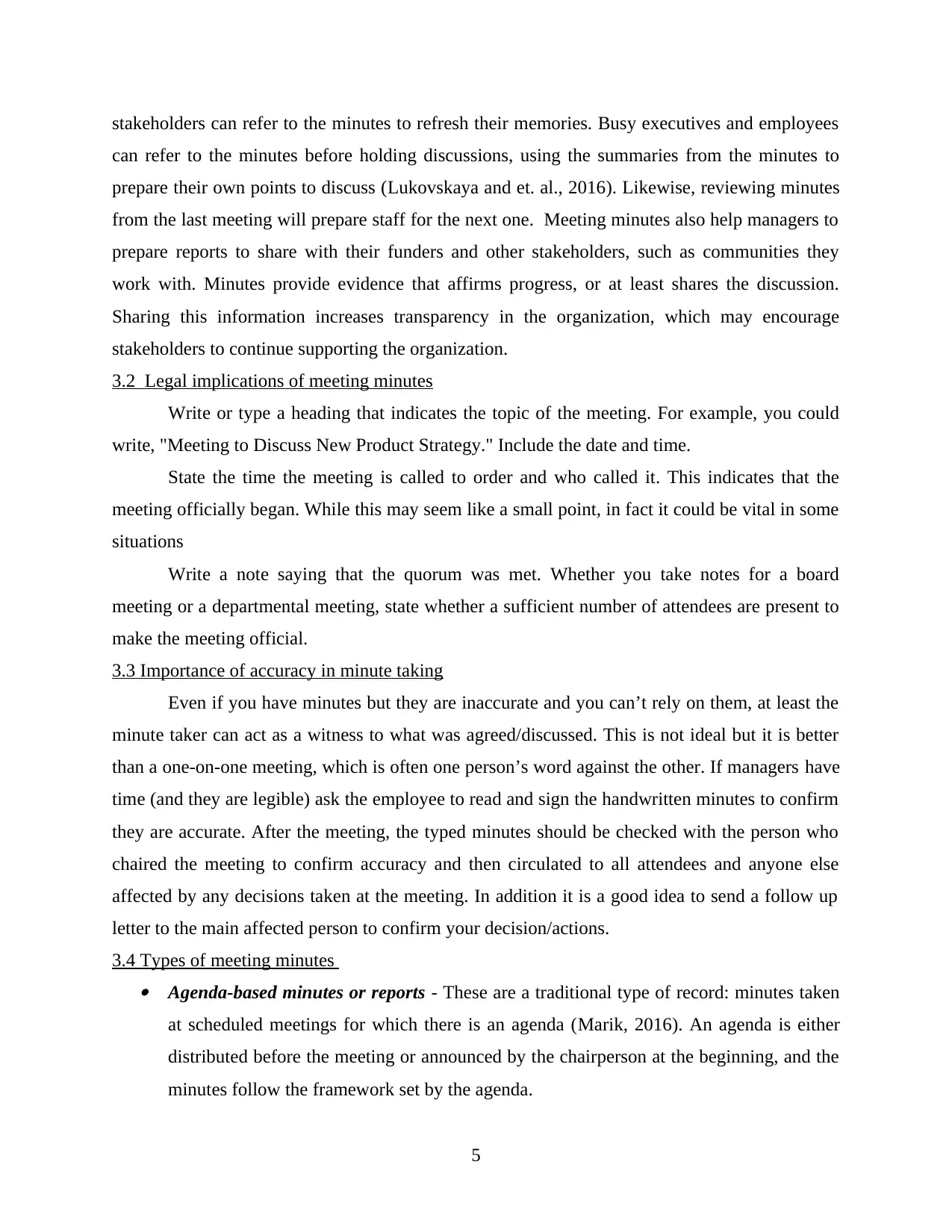
stakeholders can refer to the minutes to refresh their memories. Busy executives and employees
can refer to the minutes before holding discussions, using the summaries from the minutes to
prepare their own points to discuss (Lukovskaya and et. al., 2016). Likewise, reviewing minutes
from the last meeting will prepare staff for the next one. Meeting minutes also help managers to
prepare reports to share with their funders and other stakeholders, such as communities they
work with. Minutes provide evidence that affirms progress, or at least shares the discussion.
Sharing this information increases transparency in the organization, which may encourage
stakeholders to continue supporting the organization.
3.2 Legal implications of meeting minutes
Write or type a heading that indicates the topic of the meeting. For example, you could
write, "Meeting to Discuss New Product Strategy." Include the date and time.
State the time the meeting is called to order and who called it. This indicates that the
meeting officially began. While this may seem like a small point, in fact it could be vital in some
situations
Write a note saying that the quorum was met. Whether you take notes for a board
meeting or a departmental meeting, state whether a sufficient number of attendees are present to
make the meeting official.
3.3 Importance of accuracy in minute taking
Even if you have minutes but they are inaccurate and you can’t rely on them, at least the
minute taker can act as a witness to what was agreed/discussed. This is not ideal but it is better
than a one-on-one meeting, which is often one person’s word against the other. If managers have
time (and they are legible) ask the employee to read and sign the handwritten minutes to confirm
they are accurate. After the meeting, the typed minutes should be checked with the person who
chaired the meeting to confirm accuracy and then circulated to all attendees and anyone else
affected by any decisions taken at the meeting. In addition it is a good idea to send a follow up
letter to the main affected person to confirm your decision/actions.
3.4 Types of meeting minutes Agenda-based minutes or reports - These are a traditional type of record: minutes taken
at scheduled meetings for which there is an agenda (Marik, 2016). An agenda is either
distributed before the meeting or announced by the chairperson at the beginning, and the
minutes follow the framework set by the agenda.
5
can refer to the minutes before holding discussions, using the summaries from the minutes to
prepare their own points to discuss (Lukovskaya and et. al., 2016). Likewise, reviewing minutes
from the last meeting will prepare staff for the next one. Meeting minutes also help managers to
prepare reports to share with their funders and other stakeholders, such as communities they
work with. Minutes provide evidence that affirms progress, or at least shares the discussion.
Sharing this information increases transparency in the organization, which may encourage
stakeholders to continue supporting the organization.
3.2 Legal implications of meeting minutes
Write or type a heading that indicates the topic of the meeting. For example, you could
write, "Meeting to Discuss New Product Strategy." Include the date and time.
State the time the meeting is called to order and who called it. This indicates that the
meeting officially began. While this may seem like a small point, in fact it could be vital in some
situations
Write a note saying that the quorum was met. Whether you take notes for a board
meeting or a departmental meeting, state whether a sufficient number of attendees are present to
make the meeting official.
3.3 Importance of accuracy in minute taking
Even if you have minutes but they are inaccurate and you can’t rely on them, at least the
minute taker can act as a witness to what was agreed/discussed. This is not ideal but it is better
than a one-on-one meeting, which is often one person’s word against the other. If managers have
time (and they are legible) ask the employee to read and sign the handwritten minutes to confirm
they are accurate. After the meeting, the typed minutes should be checked with the person who
chaired the meeting to confirm accuracy and then circulated to all attendees and anyone else
affected by any decisions taken at the meeting. In addition it is a good idea to send a follow up
letter to the main affected person to confirm your decision/actions.
3.4 Types of meeting minutes Agenda-based minutes or reports - These are a traditional type of record: minutes taken
at scheduled meetings for which there is an agenda (Marik, 2016). An agenda is either
distributed before the meeting or announced by the chairperson at the beginning, and the
minutes follow the framework set by the agenda.
5
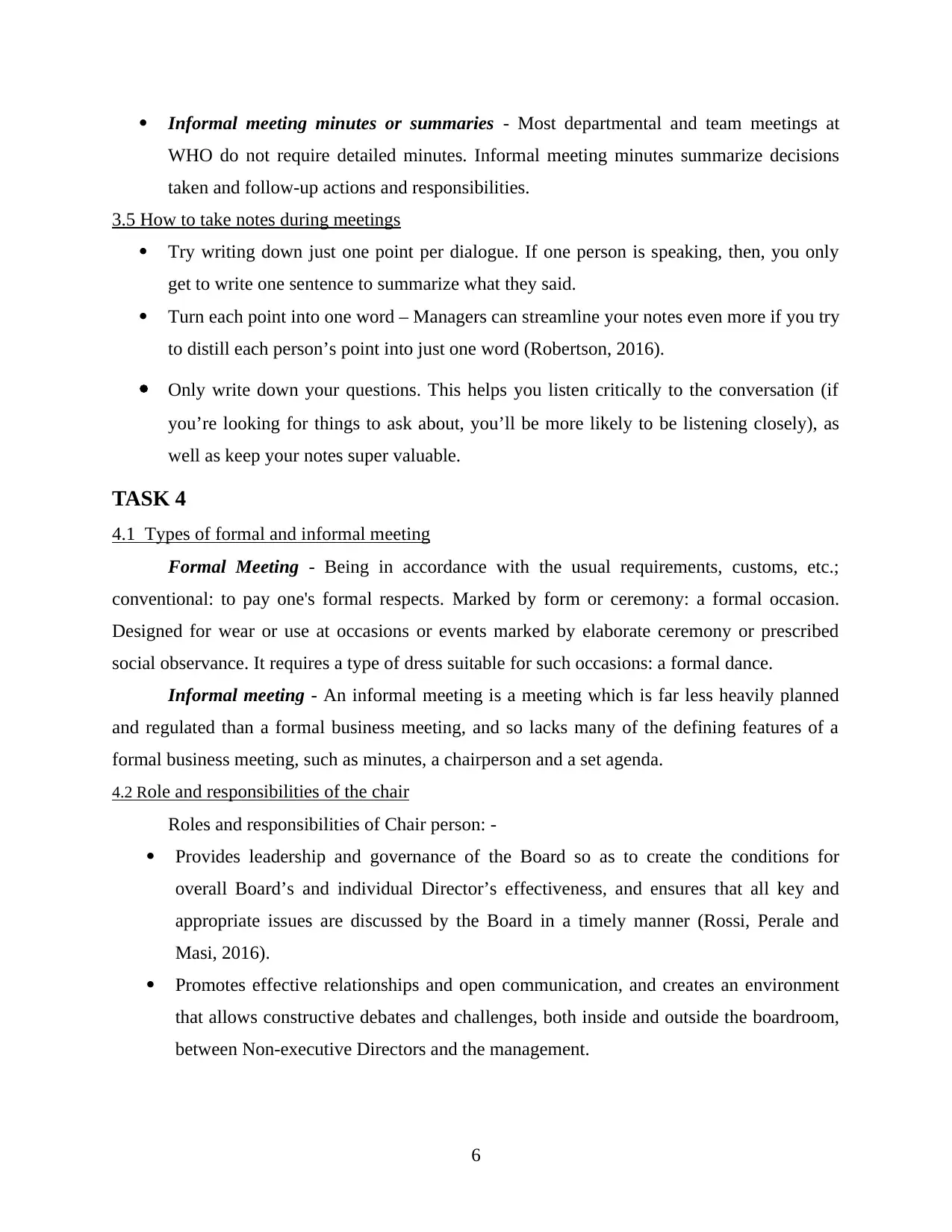
Informal meeting minutes or summaries - Most departmental and team meetings at
WHO do not require detailed minutes. Informal meeting minutes summarize decisions
taken and follow-up actions and responsibilities.
3.5 How to take notes during meetings
Try writing down just one point per dialogue. If one person is speaking, then, you only
get to write one sentence to summarize what they said.
Turn each point into one word – Managers can streamline your notes even more if you try
to distill each person’s point into just one word (Robertson, 2016).
Only write down your questions. This helps you listen critically to the conversation (if
you’re looking for things to ask about, you’ll be more likely to be listening closely), as
well as keep your notes super valuable.
TASK 4
4.1 Types of formal and informal meeting
Formal Meeting - Being in accordance with the usual requirements, customs, etc.;
conventional: to pay one's formal respects. Marked by form or ceremony: a formal occasion.
Designed for wear or use at occasions or events marked by elaborate ceremony or prescribed
social observance. It requires a type of dress suitable for such occasions: a formal dance.
Informal meeting - An informal meeting is a meeting which is far less heavily planned
and regulated than a formal business meeting, and so lacks many of the defining features of a
formal business meeting, such as minutes, a chairperson and a set agenda.
4.2 Role and responsibilities of the chair
Roles and responsibilities of Chair person: -
Provides leadership and governance of the Board so as to create the conditions for
overall Board’s and individual Director’s effectiveness, and ensures that all key and
appropriate issues are discussed by the Board in a timely manner (Rossi, Perale and
Masi, 2016).
Promotes effective relationships and open communication, and creates an environment
that allows constructive debates and challenges, both inside and outside the boardroom,
between Non-executive Directors and the management.
6
WHO do not require detailed minutes. Informal meeting minutes summarize decisions
taken and follow-up actions and responsibilities.
3.5 How to take notes during meetings
Try writing down just one point per dialogue. If one person is speaking, then, you only
get to write one sentence to summarize what they said.
Turn each point into one word – Managers can streamline your notes even more if you try
to distill each person’s point into just one word (Robertson, 2016).
Only write down your questions. This helps you listen critically to the conversation (if
you’re looking for things to ask about, you’ll be more likely to be listening closely), as
well as keep your notes super valuable.
TASK 4
4.1 Types of formal and informal meeting
Formal Meeting - Being in accordance with the usual requirements, customs, etc.;
conventional: to pay one's formal respects. Marked by form or ceremony: a formal occasion.
Designed for wear or use at occasions or events marked by elaborate ceremony or prescribed
social observance. It requires a type of dress suitable for such occasions: a formal dance.
Informal meeting - An informal meeting is a meeting which is far less heavily planned
and regulated than a formal business meeting, and so lacks many of the defining features of a
formal business meeting, such as minutes, a chairperson and a set agenda.
4.2 Role and responsibilities of the chair
Roles and responsibilities of Chair person: -
Provides leadership and governance of the Board so as to create the conditions for
overall Board’s and individual Director’s effectiveness, and ensures that all key and
appropriate issues are discussed by the Board in a timely manner (Rossi, Perale and
Masi, 2016).
Promotes effective relationships and open communication, and creates an environment
that allows constructive debates and challenges, both inside and outside the boardroom,
between Non-executive Directors and the management.
6
⊘ This is a preview!⊘
Do you want full access?
Subscribe today to unlock all pages.

Trusted by 1+ million students worldwide
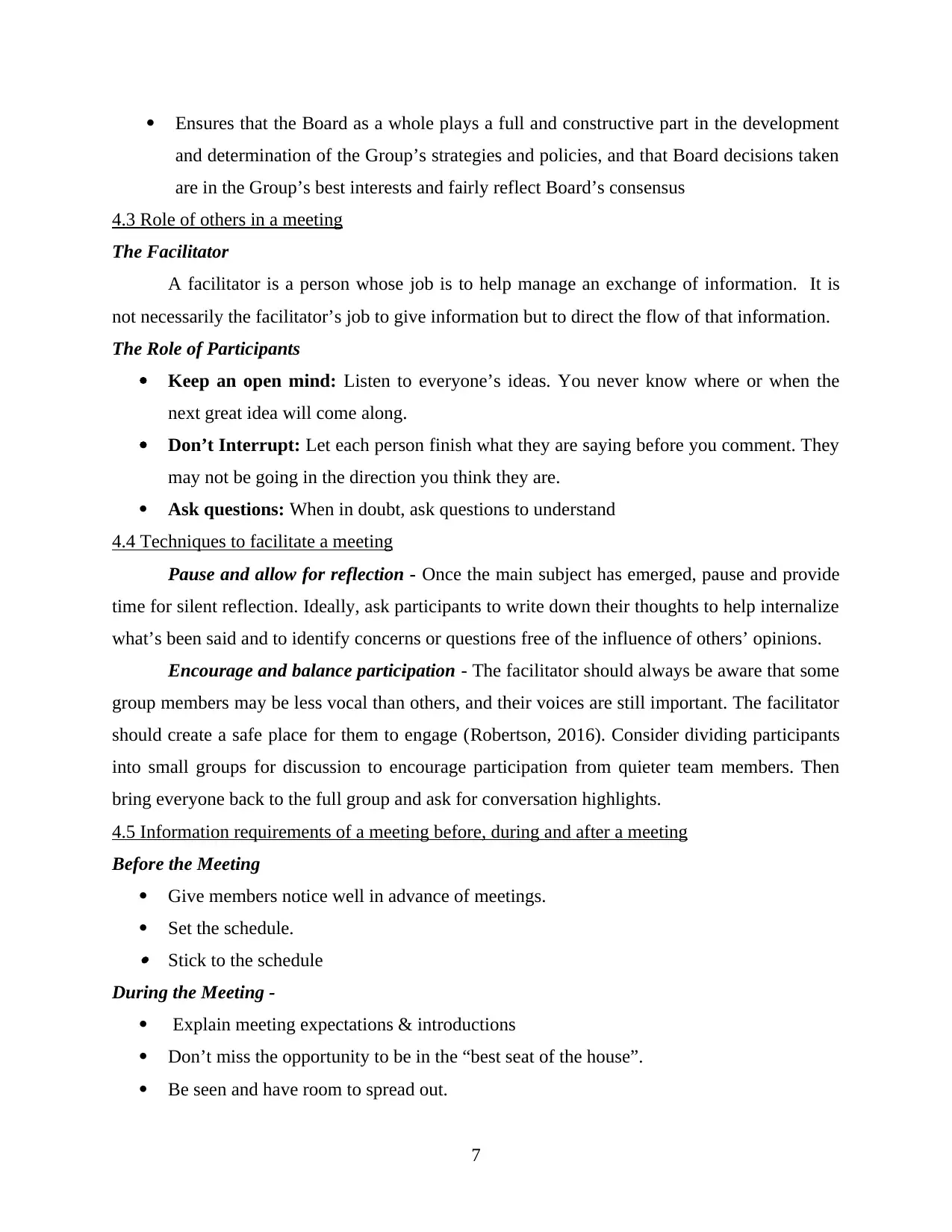
Ensures that the Board as a whole plays a full and constructive part in the development
and determination of the Group’s strategies and policies, and that Board decisions taken
are in the Group’s best interests and fairly reflect Board’s consensus
4.3 Role of others in a meeting
The Facilitator
A facilitator is a person whose job is to help manage an exchange of information. It is
not necessarily the facilitator’s job to give information but to direct the flow of that information.
The Role of Participants
Keep an open mind: Listen to everyone’s ideas. You never know where or when the
next great idea will come along.
Don’t Interrupt: Let each person finish what they are saying before you comment. They
may not be going in the direction you think they are.
Ask questions: When in doubt, ask questions to understand
4.4 Techniques to facilitate a meeting
Pause and allow for reflection - Once the main subject has emerged, pause and provide
time for silent reflection. Ideally, ask participants to write down their thoughts to help internalize
what’s been said and to identify concerns or questions free of the influence of others’ opinions.
Encourage and balance participation - The facilitator should always be aware that some
group members may be less vocal than others, and their voices are still important. The facilitator
should create a safe place for them to engage (Robertson, 2016). Consider dividing participants
into small groups for discussion to encourage participation from quieter team members. Then
bring everyone back to the full group and ask for conversation highlights.
4.5 Information requirements of a meeting before, during and after a meeting
Before the Meeting
Give members notice well in advance of meetings.
Set the schedule. Stick to the schedule
During the Meeting -
Explain meeting expectations & introductions
Don’t miss the opportunity to be in the “best seat of the house”.
Be seen and have room to spread out.
7
and determination of the Group’s strategies and policies, and that Board decisions taken
are in the Group’s best interests and fairly reflect Board’s consensus
4.3 Role of others in a meeting
The Facilitator
A facilitator is a person whose job is to help manage an exchange of information. It is
not necessarily the facilitator’s job to give information but to direct the flow of that information.
The Role of Participants
Keep an open mind: Listen to everyone’s ideas. You never know where or when the
next great idea will come along.
Don’t Interrupt: Let each person finish what they are saying before you comment. They
may not be going in the direction you think they are.
Ask questions: When in doubt, ask questions to understand
4.4 Techniques to facilitate a meeting
Pause and allow for reflection - Once the main subject has emerged, pause and provide
time for silent reflection. Ideally, ask participants to write down their thoughts to help internalize
what’s been said and to identify concerns or questions free of the influence of others’ opinions.
Encourage and balance participation - The facilitator should always be aware that some
group members may be less vocal than others, and their voices are still important. The facilitator
should create a safe place for them to engage (Robertson, 2016). Consider dividing participants
into small groups for discussion to encourage participation from quieter team members. Then
bring everyone back to the full group and ask for conversation highlights.
4.5 Information requirements of a meeting before, during and after a meeting
Before the Meeting
Give members notice well in advance of meetings.
Set the schedule. Stick to the schedule
During the Meeting -
Explain meeting expectations & introductions
Don’t miss the opportunity to be in the “best seat of the house”.
Be seen and have room to spread out.
7
Paraphrase This Document
Need a fresh take? Get an instant paraphrase of this document with our AI Paraphraser
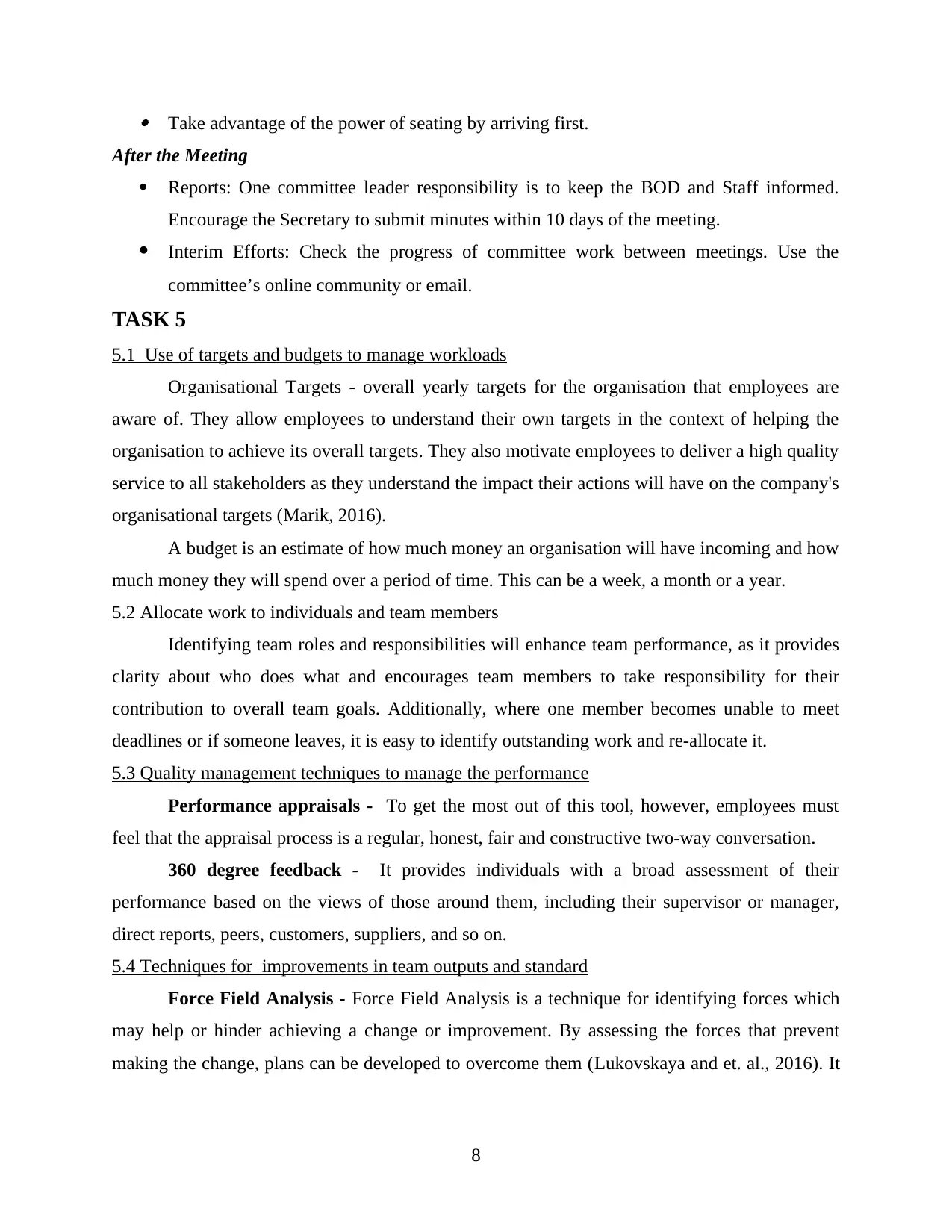
Take advantage of the power of seating by arriving first.
After the Meeting
Reports: One committee leader responsibility is to keep the BOD and Staff informed.
Encourage the Secretary to submit minutes within 10 days of the meeting.
Interim Efforts: Check the progress of committee work between meetings. Use the
committee’s online community or email.
TASK 5
5.1 Use of targets and budgets to manage workloads
Organisational Targets - overall yearly targets for the organisation that employees are
aware of. They allow employees to understand their own targets in the context of helping the
organisation to achieve its overall targets. They also motivate employees to deliver a high quality
service to all stakeholders as they understand the impact their actions will have on the company's
organisational targets (Marik, 2016).
A budget is an estimate of how much money an organisation will have incoming and how
much money they will spend over a period of time. This can be a week, a month or a year.
5.2 Allocate work to individuals and team members
Identifying team roles and responsibilities will enhance team performance, as it provides
clarity about who does what and encourages team members to take responsibility for their
contribution to overall team goals. Additionally, where one member becomes unable to meet
deadlines or if someone leaves, it is easy to identify outstanding work and re-allocate it.
5.3 Quality management techniques to manage the performance
Performance appraisals - To get the most out of this tool, however, employees must
feel that the appraisal process is a regular, honest, fair and constructive two-way conversation.
360 degree feedback - It provides individuals with a broad assessment of their
performance based on the views of those around them, including their supervisor or manager,
direct reports, peers, customers, suppliers, and so on.
5.4 Techniques for improvements in team outputs and standard
Force Field Analysis - Force Field Analysis is a technique for identifying forces which
may help or hinder achieving a change or improvement. By assessing the forces that prevent
making the change, plans can be developed to overcome them (Lukovskaya and et. al., 2016). It
8
After the Meeting
Reports: One committee leader responsibility is to keep the BOD and Staff informed.
Encourage the Secretary to submit minutes within 10 days of the meeting.
Interim Efforts: Check the progress of committee work between meetings. Use the
committee’s online community or email.
TASK 5
5.1 Use of targets and budgets to manage workloads
Organisational Targets - overall yearly targets for the organisation that employees are
aware of. They allow employees to understand their own targets in the context of helping the
organisation to achieve its overall targets. They also motivate employees to deliver a high quality
service to all stakeholders as they understand the impact their actions will have on the company's
organisational targets (Marik, 2016).
A budget is an estimate of how much money an organisation will have incoming and how
much money they will spend over a period of time. This can be a week, a month or a year.
5.2 Allocate work to individuals and team members
Identifying team roles and responsibilities will enhance team performance, as it provides
clarity about who does what and encourages team members to take responsibility for their
contribution to overall team goals. Additionally, where one member becomes unable to meet
deadlines or if someone leaves, it is easy to identify outstanding work and re-allocate it.
5.3 Quality management techniques to manage the performance
Performance appraisals - To get the most out of this tool, however, employees must
feel that the appraisal process is a regular, honest, fair and constructive two-way conversation.
360 degree feedback - It provides individuals with a broad assessment of their
performance based on the views of those around them, including their supervisor or manager,
direct reports, peers, customers, suppliers, and so on.
5.4 Techniques for improvements in team outputs and standard
Force Field Analysis - Force Field Analysis is a technique for identifying forces which
may help or hinder achieving a change or improvement. By assessing the forces that prevent
making the change, plans can be developed to overcome them (Lukovskaya and et. al., 2016). It
8
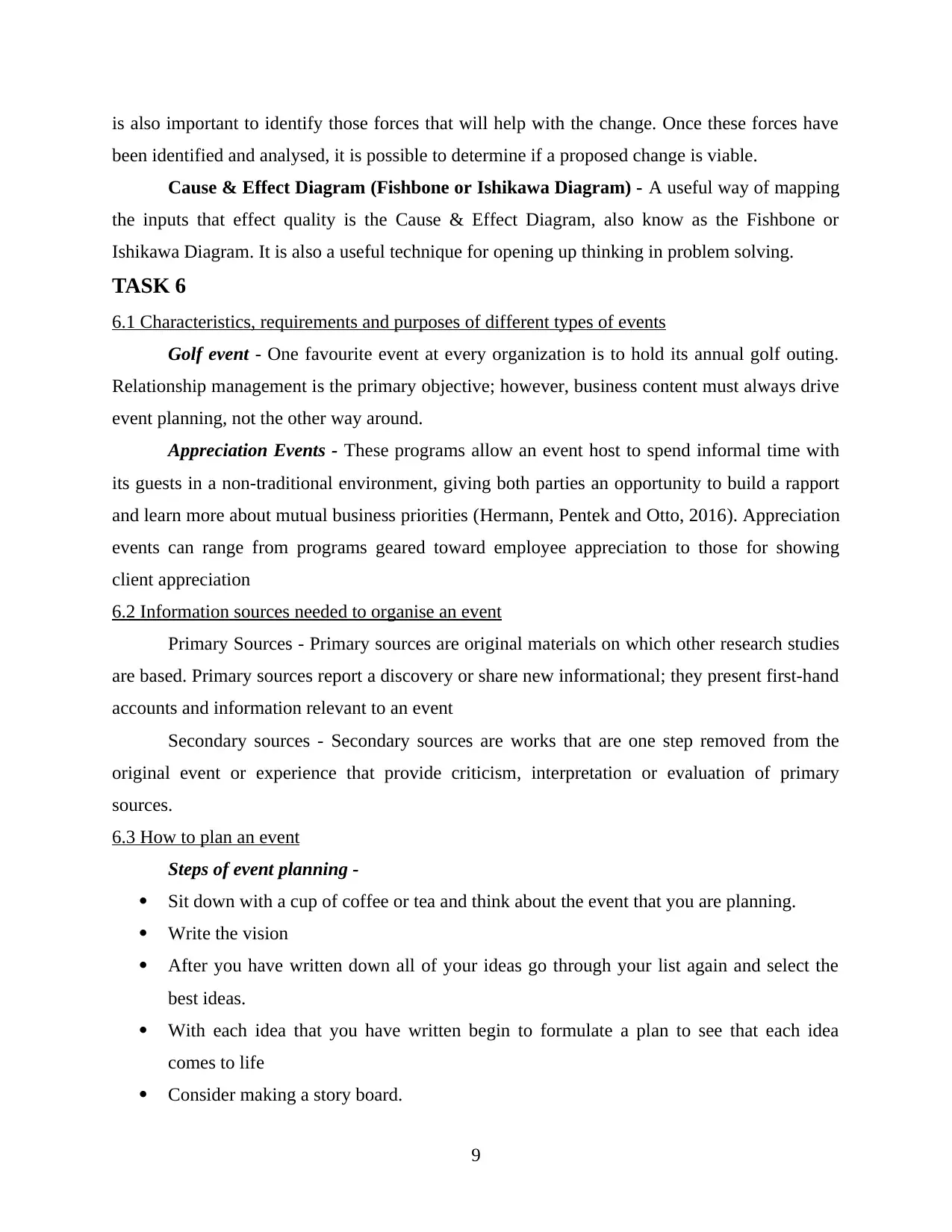
is also important to identify those forces that will help with the change. Once these forces have
been identified and analysed, it is possible to determine if a proposed change is viable.
Cause & Effect Diagram (Fishbone or Ishikawa Diagram) - A useful way of mapping
the inputs that effect quality is the Cause & Effect Diagram, also know as the Fishbone or
Ishikawa Diagram. It is also a useful technique for opening up thinking in problem solving.
TASK 6
6.1 Characteristics, requirements and purposes of different types of events
Golf event - One favourite event at every organization is to hold its annual golf outing.
Relationship management is the primary objective; however, business content must always drive
event planning, not the other way around.
Appreciation Events - These programs allow an event host to spend informal time with
its guests in a non-traditional environment, giving both parties an opportunity to build a rapport
and learn more about mutual business priorities (Hermann, Pentek and Otto, 2016). Appreciation
events can range from programs geared toward employee appreciation to those for showing
client appreciation
6.2 Information sources needed to organise an event
Primary Sources - Primary sources are original materials on which other research studies
are based. Primary sources report a discovery or share new informational; they present first-hand
accounts and information relevant to an event
Secondary sources - Secondary sources are works that are one step removed from the
original event or experience that provide criticism, interpretation or evaluation of primary
sources.
6.3 How to plan an event
Steps of event planning -
Sit down with a cup of coffee or tea and think about the event that you are planning.
Write the vision
After you have written down all of your ideas go through your list again and select the
best ideas.
With each idea that you have written begin to formulate a plan to see that each idea
comes to life
Consider making a story board.
9
been identified and analysed, it is possible to determine if a proposed change is viable.
Cause & Effect Diagram (Fishbone or Ishikawa Diagram) - A useful way of mapping
the inputs that effect quality is the Cause & Effect Diagram, also know as the Fishbone or
Ishikawa Diagram. It is also a useful technique for opening up thinking in problem solving.
TASK 6
6.1 Characteristics, requirements and purposes of different types of events
Golf event - One favourite event at every organization is to hold its annual golf outing.
Relationship management is the primary objective; however, business content must always drive
event planning, not the other way around.
Appreciation Events - These programs allow an event host to spend informal time with
its guests in a non-traditional environment, giving both parties an opportunity to build a rapport
and learn more about mutual business priorities (Hermann, Pentek and Otto, 2016). Appreciation
events can range from programs geared toward employee appreciation to those for showing
client appreciation
6.2 Information sources needed to organise an event
Primary Sources - Primary sources are original materials on which other research studies
are based. Primary sources report a discovery or share new informational; they present first-hand
accounts and information relevant to an event
Secondary sources - Secondary sources are works that are one step removed from the
original event or experience that provide criticism, interpretation or evaluation of primary
sources.
6.3 How to plan an event
Steps of event planning -
Sit down with a cup of coffee or tea and think about the event that you are planning.
Write the vision
After you have written down all of your ideas go through your list again and select the
best ideas.
With each idea that you have written begin to formulate a plan to see that each idea
comes to life
Consider making a story board.
9
⊘ This is a preview!⊘
Do you want full access?
Subscribe today to unlock all pages.

Trusted by 1+ million students worldwide
1 out of 14
Related Documents
Your All-in-One AI-Powered Toolkit for Academic Success.
+13062052269
info@desklib.com
Available 24*7 on WhatsApp / Email
![[object Object]](/_next/static/media/star-bottom.7253800d.svg)
Unlock your academic potential
Copyright © 2020–2025 A2Z Services. All Rights Reserved. Developed and managed by ZUCOL.





